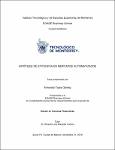Mostrar el registro sencillo del ítem
Hipótesis de eficiencia en mercados automatizados
| dc.contributor.advisor | Reyna Miranda, Montserrat | |
| dc.contributor.author | Tapia Gómez, Armando | |
| dc.date.accessioned | 2020-07-06T19:38:59Z | |
| dc.date.available | 2020-07-06T19:38:59Z | |
| dc.date.created | 2019 | |
| dc.identifier.citation | Tapia, Armando (2019). Hipótesis de Eficiencia en Mercados Automatizados. (Tesis doctorado). Instituto Tecnológico y de Estudios Superiores de Monterrey. https://hdl.handle.net/11285/636543 | es_MX |
| dc.identifier.uri | https://hdl.handle.net/11285/636543 | |
| dc.description | 379895 | es_MX |
| dc.description.abstract | The present work shows an analysis of the Market Efficiency Hypothesis (MEH) adapted to the technological conditions. In this research it is proposed to consider whether a market is efficient or not in the terms of Fama (1970), through empirical measures of distribution and autocorrelation for assets traded in both Mexican United States (US) stock markets, using different time scales, in order to identify whether or not the incorporation of electronic operations creates an anomaly in the markets that, according to the MEH, prices instantly incorporate all public information and follow a random walk, so that it is not possible to generate extraordinary profits, this Hypothesis finds challenges as evidence that price returns do not present a normal distribution and a strong correlation between returns in very small time intervals is found, which is a clear sign that the speed of algorithmic operations are in an exclusive field of competence and a regular person is not even close to trade in the same way. This implies that the HEM is not met when returns are calculated in very small time intervals, so it runs with limitations where the Hypothesis is valid in time intervals above 10 days on average, however on the other side of those limits, below that interval, there is a dynamic of the returns that does not obey the fundamentals of the Fama Hypothesis. In this research, normality tests are carried out using Jarque-Bera (1980) test and with the characteristic alpha exponent of Lévy's alpha-stable distributions (1925), achieving greater knowledge of the evolution of the distribution for different time scales, tests of autocorrelation between the returns of each stock with the Ljung-Box (1978) test, resulting in that for very short intervals there is correlation in the returns while for intervals above 10 days a random walk with an asymptotically normal distribution is identified. | es_MX |
| dc.format.medium | Texto | es_MX |
| dc.language.iso | spa | es_MX |
| dc.publisher | Instituto Tecnológico y de Estudios Superiores de Monterrey | es_MX |
| dc.relation.isFormatOf | versión publicada | es_MX |
| dc.rights | openAccess | es_MX |
| dc.rights.uri | http://creativecommons.org/licenses/by-nc-nd/4.0 | es_MX |
| dc.subject.classification | CIENCIAS SOCIALES::CIENCIAS ECONÓMICAS::ORGANIZACIÓN INDUSTRIAL Y POLÍTICA PÚBLICA::ESTRUCTURA DEL MERCADO | es_MX |
| dc.subject.lcsh | Social Sciences | es_MX |
| dc.title | Hipótesis de eficiencia en mercados automatizados | es_MX |
| dc.type | Tesis Doctorado / doctoral Thesis | es_MX |
| dc.contributor.department | EGADE | es_MX |
| dc.contributor.committeemember | Mata Mata, Leovardo | |
| dc.contributor.mentor | Mansilla Corona, Ricardo Lino | |
| dc.contributor.mentor | Amorós Espinoza José Ernesto | |
| dc.subject.keyword | Markets Efficiency | es_MX |
| dc.subject.keyword | High Frequency Trading | es_MX |
| dc.subject.keyword | alpha-stable distributions | es_MX |
| dc.subject.keyword | Stocks | es_MX |
| dc.contributor.institution | Campus Santa Fe | es_MX |
| dc.contributor.cataloger | emipsanchez | es_MX |
| dc.description.degree | Doctor en Ciencias Financieras | es_MX |
| dc.identifier.cvu | 640618 | es_MX |
| dc.audience.educationlevel | Investigadores/Researchers | es_MX |
| dc.audience.educationlevel | Público en general/General public | es_MX |
| dc.relation.impreso | 2019-11-21 | |
| dc.identificator | 5||53||5309||530904 | es_MX |
Ficheros en el ítem
Este ítem aparece en la(s) siguiente(s) colección(ones)
-
Ciencias Sociales 565
Gobierno y Transformación Pública / Humanidades y Educación / Negocios / Arquitectura y Diseño / EGADE Business School



